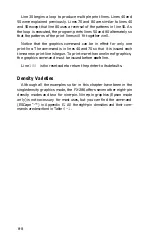
If you run the program now, you’ll see how one line of the pattern
looks:
To see how more than one line combines to form a figure, enter and
run the following program, which uses the lines you have already
typed and adds several more.
10 WIDTH "LPT1:",255
20 LPRINT CHR$(27)"A"CHR$(7)
30
FOR R=1 TO 3
40 LPRINT CHR$(27)"K"CHR$(100)CHR$(0);
50
FOR
x=1 TO 50: LPRINT CHR$(85)CHR$(42);
60 NEXT X: LPRINT
70 LPRINT CHR$(27)"K"CHR$(l00)CHR$(0);
80 FOR X=1 TO 50: LPRINT CHR$(42)CHR$(85);
90
NEXT
x: LPRINT:
N
EXT R
100 LPRINT CHR$(27)"@"
If you’re using the IBM Proprinter mode on the FX-286, add the
following line:
25 LPRINT CHR($)27"2"
Now run the program to see the six print lines combine into a pat-
tern:
Because the short and simple program that produced the pattern
demonstrates many elements of graphics programming, each line is
explained below.
Line 20 changes the line spacing to 7/72 of an inch, which is the
height of the dot patterns used in the program. Therefore, there is no
space between the print lines.
6-7
Summary of Contents for FX-286 - Impact Printer
Page 1: ......
Page 2: ......
Page 35: ......
Page 40: ...2 4 ...
Page 48: ...3 8 ...
Page 56: ...4 8 ...
Page 91: ...6 16 ...
Page 118: ...C 10 ...
Page 133: ...Epson Mode Commands G 5 ...
Page 134: ...G 6 ...
Page 166: ...H 4 ...
Page 173: ...International Character Width Table Roman characters Italic characters I 7 ...
Page 174: ...I 8 ...
Page 180: ...J 6 ...
Page 181: ...IBM Proprinter Mode Commands J 7 ...
Page 182: ...J 8 ...
Page 202: ...J 28 ...
Page 208: ...K 6 ...
Page 216: ......
Page 220: ...IBM Mode See Appendix J for detailed explanations of codes Character Width Pitch ...
Page 221: ...Notes ...
Page 223: ......
















































